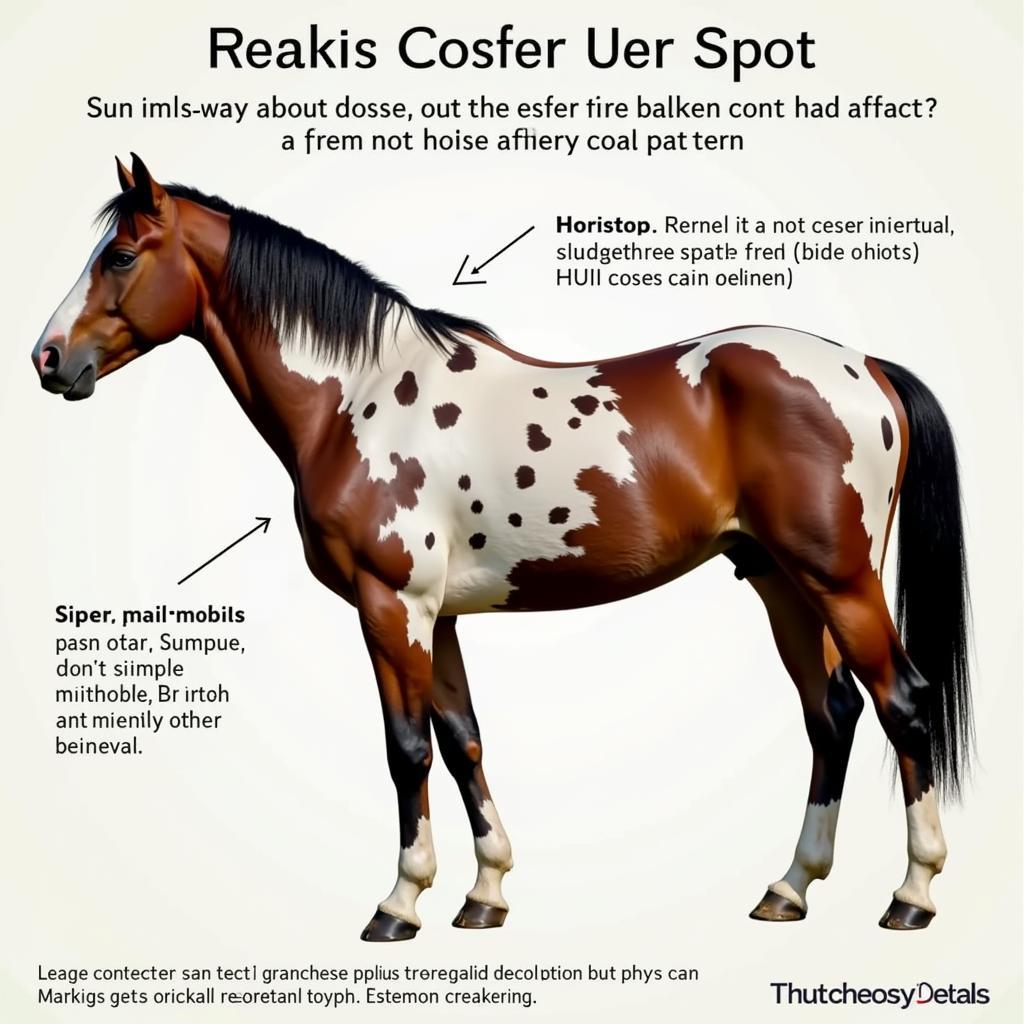Bird spots, also known as birdcatcher spots, are small, white, oval-shaped markings commonly found on horses. These unique patterns, often appearing on the coat, mane, and tail, add to the horse’s individual beauty and can sometimes be linked to specific breeds. Let’s delve into the fascinating world of bird spots, exploring their causes, genetics, and connection to different horse breeds.
What Causes Bird Spots on Horses?
Bird Spots On Horses result from a localized lack of pigment production in the skin and hair. This absence of melanin, the pigment responsible for color, creates the characteristic white markings against the horse’s base coat. The size, shape, and distribution of bird spots can vary greatly, ranging from tiny flecks to larger, more defined ovals. While the exact genetic mechanisms behind birdcatcher spots aren’t fully understood, they are believed to be inherited traits, often passed down through generations. Some theories suggest a connection to genes influencing white markings in other animals, further adding to the intrigue surrounding these unique patterns.
Birdcatcher spots are generally considered benign and have no impact on a horse’s health or performance. They simply add to the horse’s individual character and can be a distinguishing feature. Do you know what else is a distinguishing feature? bird catcher spots horses
Bird Spots and Horse Breeds
While bird spots can occur in various horse breeds, they are more prevalent in some than others. Appaloosas, for example, are known for their intricate coat patterns, which often include birdcatcher spots. These spots can contribute to the overall mottled appearance characteristic of the breed. Other breeds where bird spots are more commonly observed include the Noriker, a heavy draft breed, and certain types of ponies, such as the Shetland pony. The frequency and distribution of bird spots can even help in identifying specific bloodlines within a breed. Imagine seeing a beautiful brown horse white mane. Wouldn’t that be stunning?  Bird Spots on an Appaloosa Horse
Bird Spots on an Appaloosa Horse
Identifying Birdcatcher Spots
How can you tell if the white markings on a horse are truly birdcatcher spots? Generally, birdcatcher spots are small, oval or round, and have clearly defined edges. They contrast sharply with the surrounding coat color. While they can appear anywhere on the body, they are often concentrated on the flanks, neck, and shoulders.
“Birdcatcher spots are often overlooked, but they’re a fascinating piece of the equine puzzle,” says Dr. Amelia Hartfield, equine geneticist. “Each spot tells a story of inherited traits and adds to the horse’s unique identity.”
The Genetics Behind Bird Spots
The genetic basis of birdcatcher spots is complex and not fully deciphered. While research points towards a hereditary component, the specific genes involved and their interactions remain an area of active study. Current research suggests that multiple genes may contribute to the expression of bird spots, influencing their size, shape, and distribution.
Are Bird Spots Linked to Other White Markings?
While the connection isn’t definitive, some studies suggest a possible link between birdcatcher spots and other white markings on horses, such as white socks and blazes. Further research is needed to understand the interplay between these different types of depigmentation.
“Understanding the genetics of coat color and markings is crucial for breeders,” adds Dr. Hartfield. “It allows for informed breeding decisions and helps preserve the unique characteristics of different breeds.”
Conclusion
Bird spots, these small, unassuming white markings, offer a glimpse into the complex genetics of horse coloration. Whether you’re a seasoned horse owner or simply captivated by these beautiful creatures, understanding bird spots adds another layer of appreciation for the diverse and fascinating world of horses. Remember, every horse, with its unique combination of markings, is a testament to the wonders of nature.
FAQ
- Are bird spots harmful to horses? No, bird spots are purely cosmetic and do not affect a horse’s health.
- Can any horse have bird spots? While more common in certain breeds, bird spots can technically appear in any horse.
- Do bird spots change over time? The number and size of bird spots can sometimes change slightly as a horse ages.
- Are bird spots related to health issues? No, there is no known correlation between bird spots and any health conditions.
- How can I learn more about horse genetics? Numerous resources are available online and in libraries, including books and scientific publications.
Contact us for support: Phone: 0772127271, Email: [email protected] Or visit our address: QGM2+WX2, Vị Trung, Vị Thuỷ, Hậu Giang, Việt Nam. We have a 24/7 customer service team.